It’s hard to believe that Abu Dhabi in the United Arab Emirates was once a modest fishing village. But over the past five decades, the Emirati capital has become an epicenter for contemporary architecture as awe-inspiring towers dominate the skyline. Priding itself on masterpieces ranging from the new Qasr Al Watan to the leaning Capital Gate, Abu Dhabi has evolved into a thriving modern city.
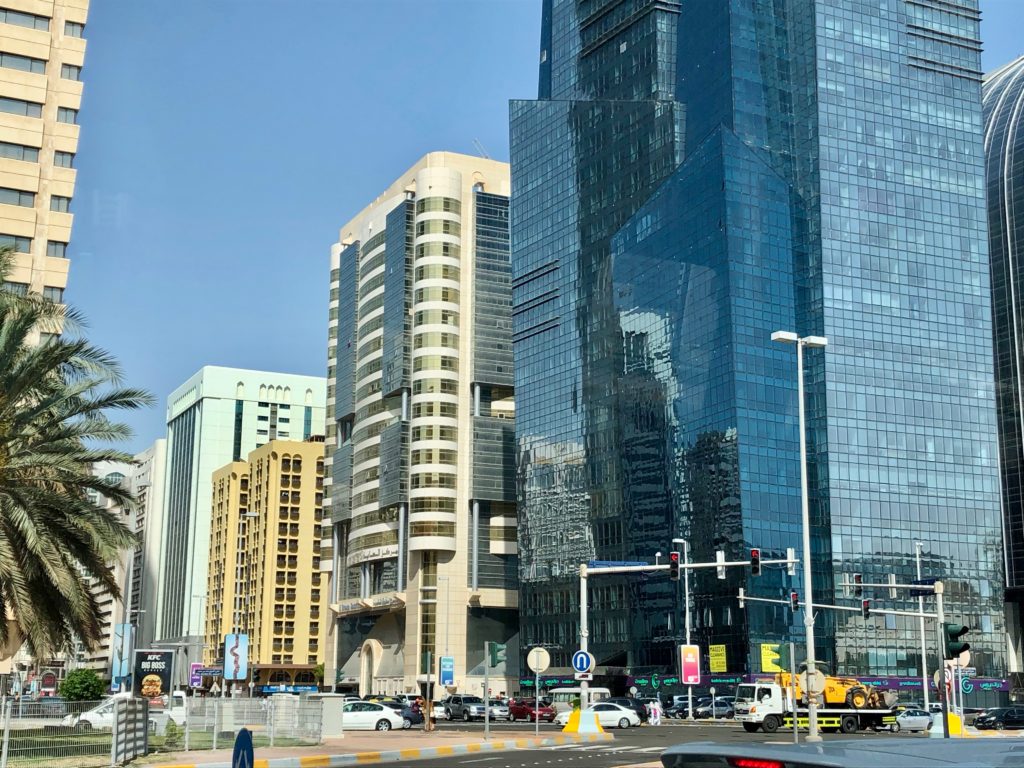
Once a modest fishing village, Abu Dhabi has evolved into a thriving modern city. (Photo: Tracy Kaler)
Sitting 87 miles from Dubai, the UAE capital Abu Dhabi is an isle extending into the Persian Gulf. Calmer and more conservative than glamorous, high-profile Dubai, Abu Dhabi – which translates as ‘father of the gazelle’ in Arabic – is also the largest of the seven emirates by area.
The city acts as Abu Dhabi’s commercial and cultural hub. Similar to Dubai, the emirate maintains an outward-looking consistency in its approach to its evolution, as well as a commitment to tolerance and peace. While Abu Dhabi can’t lay claim to the famed Burj Khalifa – the world’s tallest skyscraper located in Dubai – the city’s architecture is making ground on its cooler cousin. A far cry from the modest village it was in the 19th and early 20th century, the Abu Dhabi of today is in the midst of a massive construction boom.
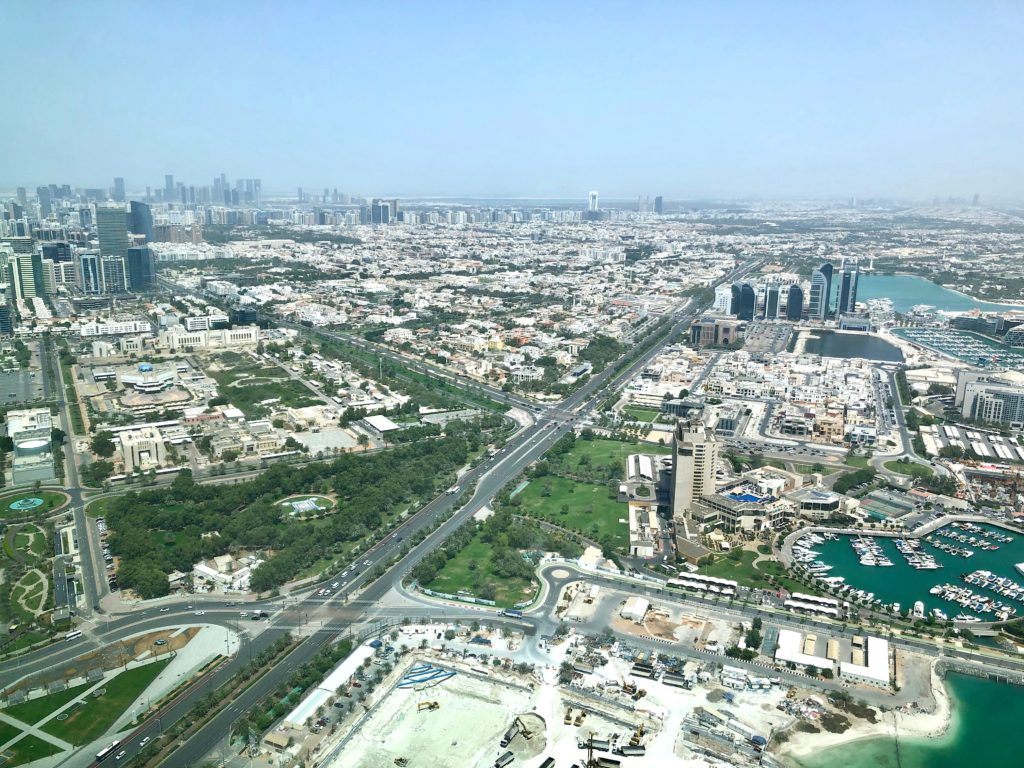
Abu Dhabi is in the midst of a massive construction boom. (Photo: Tracy Kaler)
How Abu Dhabi Became a Metropolis
Dating as far back as 8,000 years, Abu Dhabi was once an unoccupied stretch of desert. When the Bani Yas tribe settled there in the 18th century (after drinking water was discovered), the island evolved into a modest fishing village before eventually establishing itself as a hub for the pearl industry. But it was with the discovery of oil in 1958 alongside the opening of al Batten Airport in 1969 and the subsequent founding of the UAE two years later that led the emirate toward a gradual and dramatic transformation. Since then, the city-state has developed into a dynamic global destination marked by cultural and financial growth, a place that is forward-thinking but which still retains its distinct Middle Eastern heritage.
In 1980, the completion of E11 – the coastal highway connecting Abu Dhabi to Dubai (and Abu Dhabi’s main urban artery) – allowed easy access from one emirate to the other. Two years later, the new Abu Dhabi International Airport opened on the mainland, allowing more travelers access to the emirate. Eventually, Abu Dhabi Mall and Marina Mall arrived. In 2003, with the founding of Etihad Airways, Abu Dhabi was prepared to welcome the world.
The iconic Emirates Palace, a seven-star luxury hotel and resort, opened its doors in 2005 after four years in construction. This was joined by numerous luxury properties as well as innovative high-rises, and soon the young city we see today began to take shape. Since then, Sky Tower, Etihad Towers, Sheikh Zayed Bridge, The Landmark, and an array of modern architectural wonders have risen in Abu Dhabi’s sky.
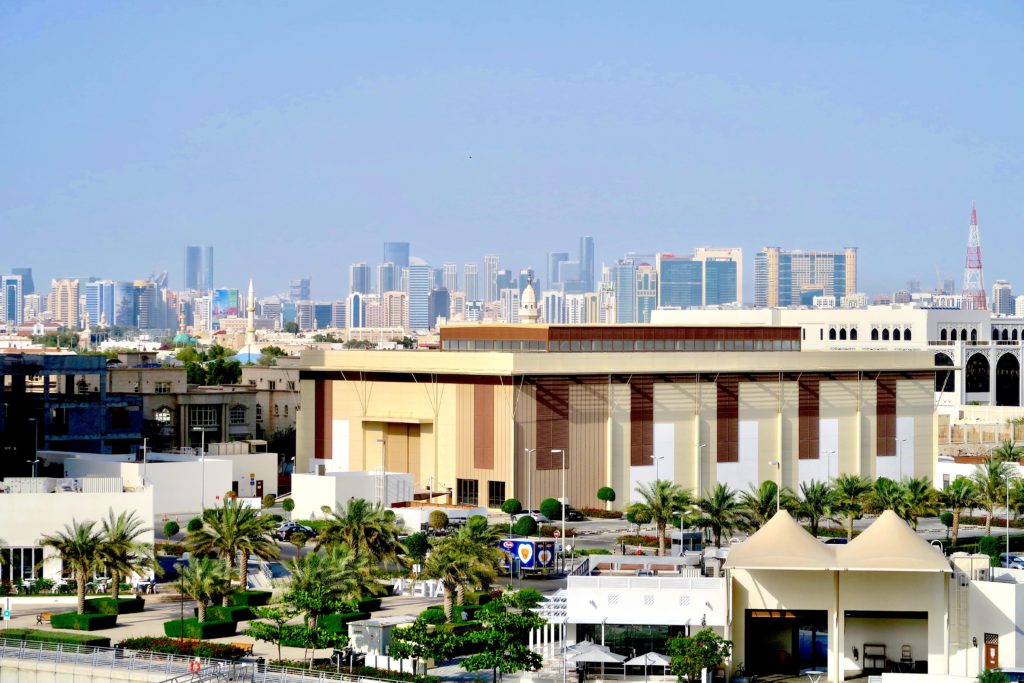
Abu Dhabi’s skyline rises in the distance. (Photo: Tracy Kaler)
As it continues to expand, the emirate attracts more international travelers each year (according to Gulf News, hotel guests were up four percent in 2018 over 2017), many of whom aspire to visit and observe the development, watching a centuries-old island morph into a 21st-century metropolis. Meanwhile, award-winning architects leave their stamp on Abu Dhabi, and its future looks bright and exciting. The next decade will undoubtedly reveal a denser, glass-filled skyline and a very different city from the Abu Dhabi we see in 2019.
Can’t-Miss Architecture in Abu Dhabi
Begin with one of the most beautiful (and photographed) religious buildings in the world, Sheikh Zayed Grand Mosque (Sheikh Rashid Bin Saeed St), a destination unto itself. Highlighting Persian, Mughal and Moorish styles, the mosque is named after the UAE’s first president, the late Sheikh Zayed bin Sultan Al Nahyan. Characterized by 82 white marble-clad domes, more than 1,000 exterior columns, and 96 jewel-sheathed interior columns, the place of worship houses seven 24-karat gold chandeliers and the world’s largest hand-knotted area rug, measuring more than 60,000 square feet. The mosque’s design team included Syrian architect Yousef Abdelky and British artist and illustrator Kevin Dean who is responsible for the unique floral detailing throughout.
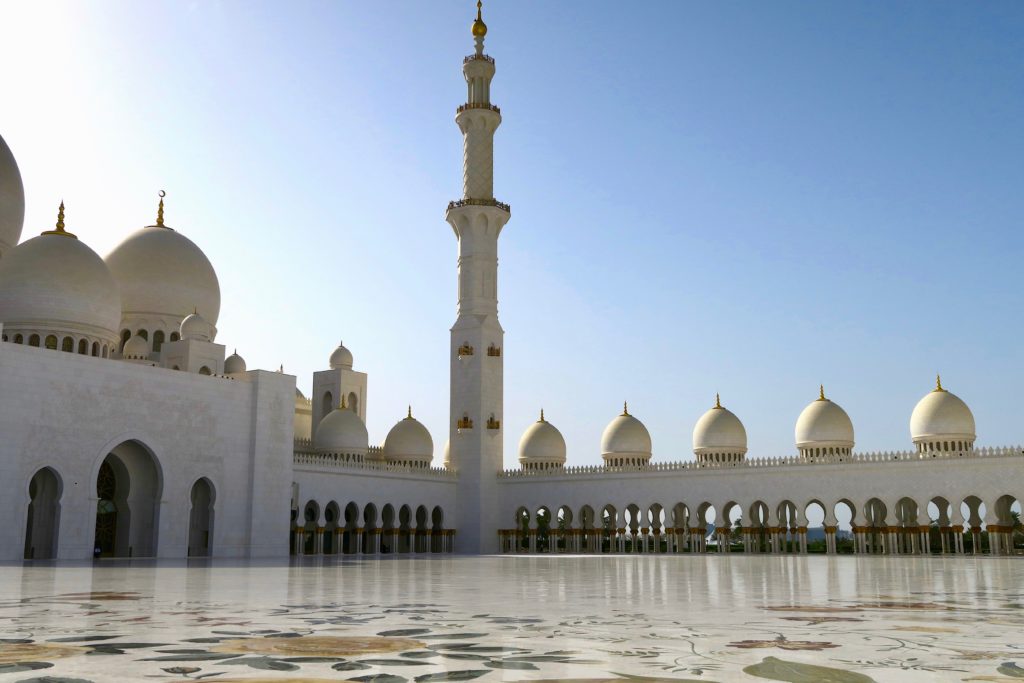
Sheikh Zayed Grand Mosque is one of the most photographed religious buildings in the world. (Photo: Tracy Kaler)
Designed by Abdulmajid Karanouh and the team at Aedas Studio, the Al Bahr Towers (Al Hilal Bank) are constructed of reinforced concrete and steel and feature a responsive facade. Built as headquarters for the Abu Dhabi Investment Council, the high-tech skyscrapers combat heat gain through a “mashribaya,” or shading mechanism, modeled after the wooden latticework often used in Islamic architecture. This outer skin filters light and reduces glare, with the vertical strip of the mashribaya moving with the sun, exposing more of the underlayer in the evening.
Saadiyat Island Cultural District is the emirate’s crown jewel of projects and the headquarters for a museum trio – The Zayed National Museum, The Guggenheim, and the Louvre Abu Dhabi. While the development of the Guggenheim and the Zayed National Museum are still in progress (as of summer 2019) the Louvre Abu Dhabi (Saadiyat), a joint effort between the governments of Abu Dhabi and France, opened in November 2017. The most impressive element of this Jean Nouvel masterpiece is the ethereal geometric-patterned dome hovering above, with 7,850 star-shaped perforations creating a “rain of light” trickling into the spaces beneath it.
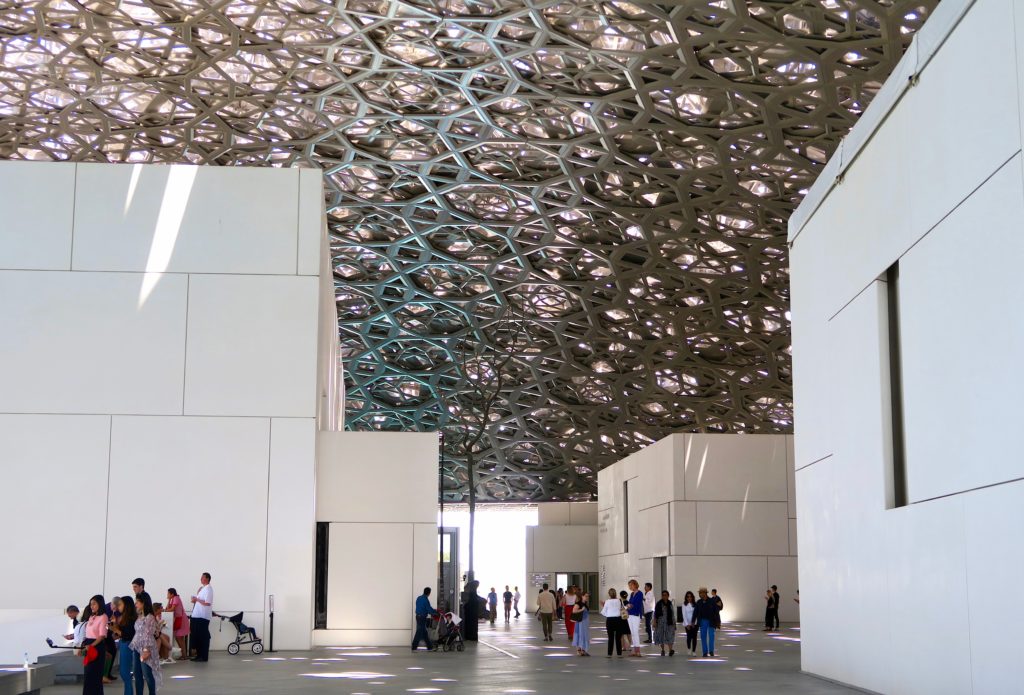
Jean Nouvel’s Louvre Abu Dhabi features an ethereal geometric patterned dome, trickling a “rain of light.” (Photo: Tracy Kaler)
Three skyscrapers comprise the World Trade Center Abu Dhabi (Garden Tower). Housing residential space, the Burj Mohammed bin Rashid rises to 92 stories, and the neighboring Trust Tower features 60 floors of office space including those of the World Trade Center’s Association. The shortest of the three, the Central Market Hotel Tower houses a 16-floor Courtyard by Marriott. The souk and shopping mall connecting the hotel to Trust Tower – which is a draw on its own – sells food and crafts as well as luxury items.
Spectacular, lavish, and mystical at the same time, Qasr Al Watan (Al Ras Al Akhdar) or “Palace of the Nation” is an astonishing landmark that opened in March 2019. Much more than a presidential palace, it is a treasure trove overflowing with Arab culture and history, dedicated to preserving the country’s heritage and telling the story of the UAE’s past while peering into the future. The highlight of Qasr Al Watan – with its opulent abundance of stone, gilding, and intricate patterns – is the Great Hall. Truly a sight to behold, this ornate space’s central dome reaches almost 200 feet in height.
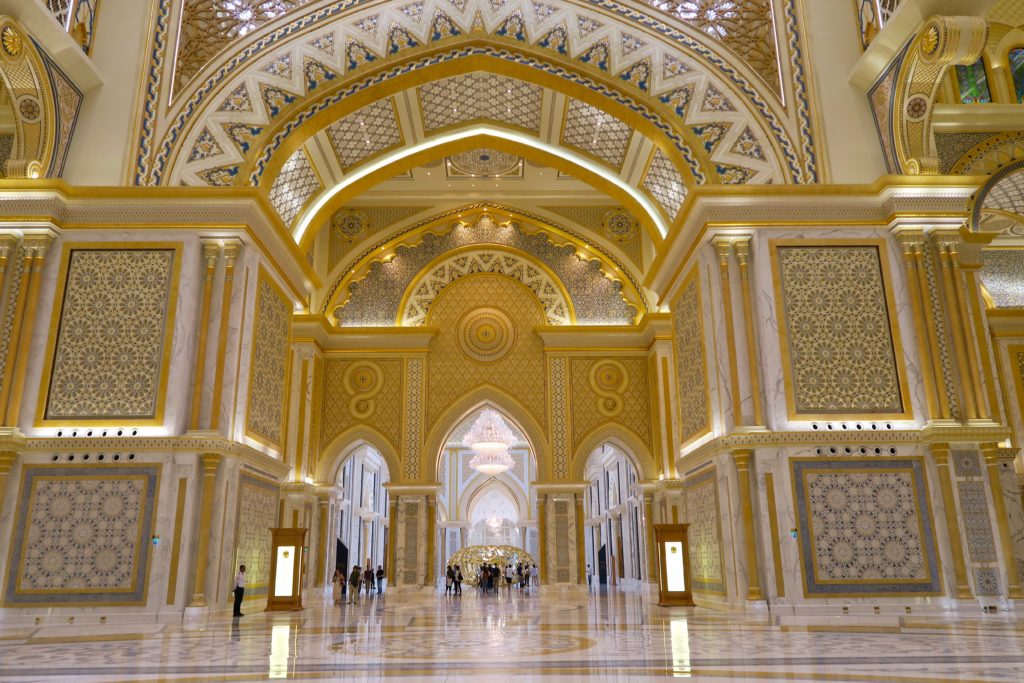
Qasr Al Watan’s Great Hall is truly a sight to behold. (Photo: Tracy Kaler)
Driving through Abu Dhabi at night, it’s nearly impossible to miss the lights changing colors on the Sheikh Zayed Bridge. The Zaha Hadid-designed structure connects Abu Dhabi island to the mainland and exhibits a spectrum of bold colors after dark. Inspired by the undulating shape of dunes, the bridge’s continuous waves extend 229 feet high while bending around two four-lane roads that span over 2,700 feet. This revolutionary silhouette is astonishing to see and thought of as the most complex bridge built in history.
Set in the center of Abu Dhabi, Qasr Al Hosn (Rashid Bin Saeed Al Maktoum St or 2nd St) is the city’s oldest building. Though the Outer Fort was built from 1939 to 1945, the Inner Fort dates back to the late 18th century. This stone structure once housed the watchtower protecting the island’s burgeoning settlement, but Qasr Al Hosn has also been the residence of the ruling family and the government headquarters. Today, it’s a museum dedicated to preserving Abu Dhabi’s rich history, its origins as a fishing village that ambitiously molded itself into a robust international city.
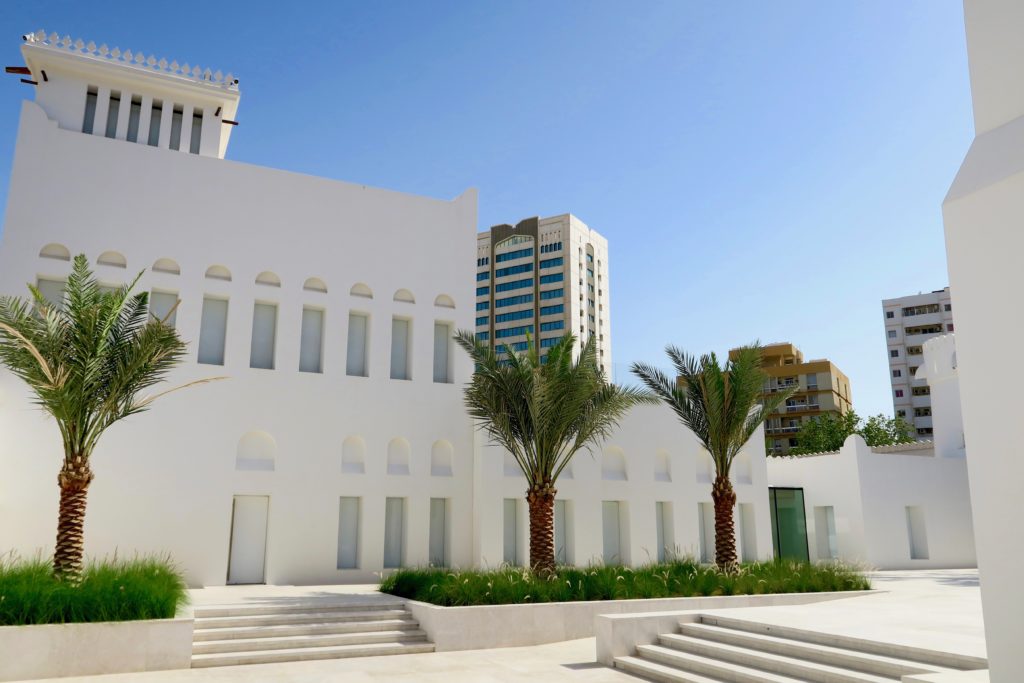
Abu Dhabi’s oldest building, Qasr Al Watan is a museum dedicated to preserving Abu Dhabi’s rich history. (Photo: Tracy Kaler)
Italy has the leaning tower of Pisa, and Abu Dhabi has the Capital Gate Tower, a skyscraper designed and built to lean at an 18-degree angle. The architectural prowess of this 35-story elegant structure can’t be missed. Set on Capital Centre – one of Abu Dhabi’s largest mixed-use developments – the tower contains 170,000 square feet of office space and Hyatt’s Andaz Hotel – a luxury property that feels a lot like a modern art museum – on the 18th through 33rd floors.
Revel in luxury when you book a stay at Emirates Palace (Sheikh Zayed Road) – a seven-star hotel and resort swathed in gold and marble that indeed feels like it was built for royalty. Palatial public spaces, 394 residences, two spas, two helicopter landing pads, and its own beach and marina signify that Emirates Palace is no ordinary property. With one massive dome and 114 mini-domes, the resort celebrates Islamic design principles, and the interior reflects the earthy colors of the desert landscape. Even if you’re not a hotel guest, the palace is open to visitors and guided tours are available.
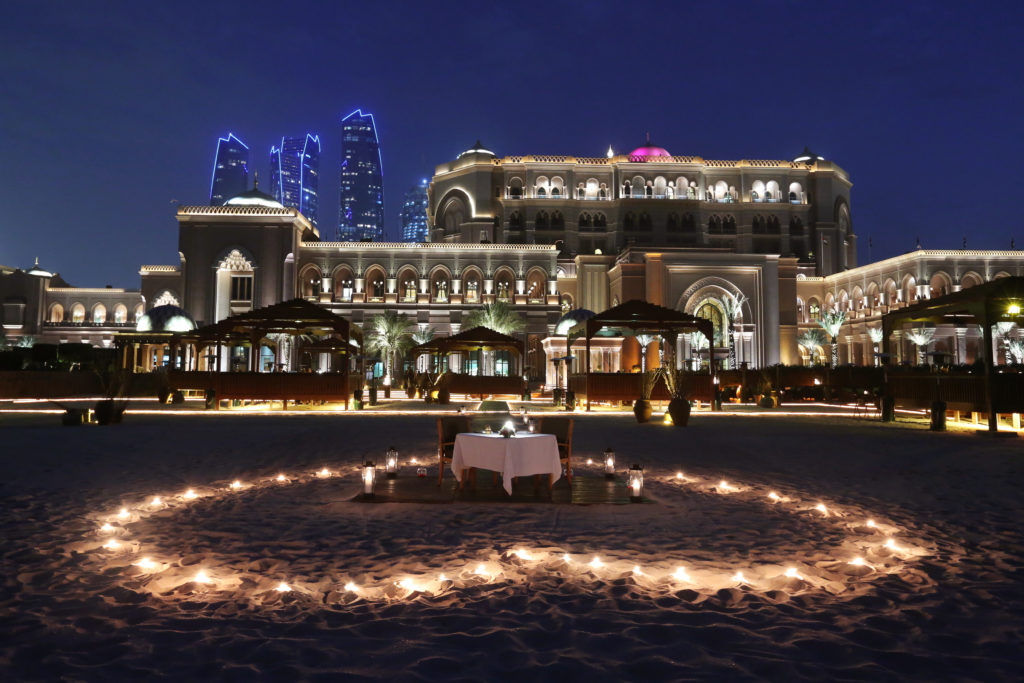
Emirates Palace feels like it was built for royalty. (Photo: Abu Dhabi Tourism)
When driving on the E11, you can’t ignore the Aldar HQ Building, the first spherical structure of its kind in this area of the world. From afar, the 23-story HQ resembles an object more than an office building, but as one approaches, this shiny round tower seems to sprout from the sea. Also dubbed the “Coin Building,” the circular standout was designed on a diagrid or diagonal steel grid structure. The award-winning building features flexible, open-plan office space and astonishing views over the city, the Grand Canal and the sea.
A cluster of five skyscrapers, Etihad Towers (Corniche West Street, Opp Emirates Palace Hotel) is a multi-use development with offices, residential space, and a five-star 382-room Jumeirah property. Set in the Al Ras Al Akhdar district near the Corniche – Abu Dhabi’s waterfront promenade and recreation area – Etihad Towers also offers one of the emirate’s most elaborate convention centers, underground parking, an array of restaurants showcasing international cuisine, designer boutiques, and its own private beach. The buildings range from 54 to 75 stories, showcasing some of the most captivating vistas in all of Abu Dhabi.
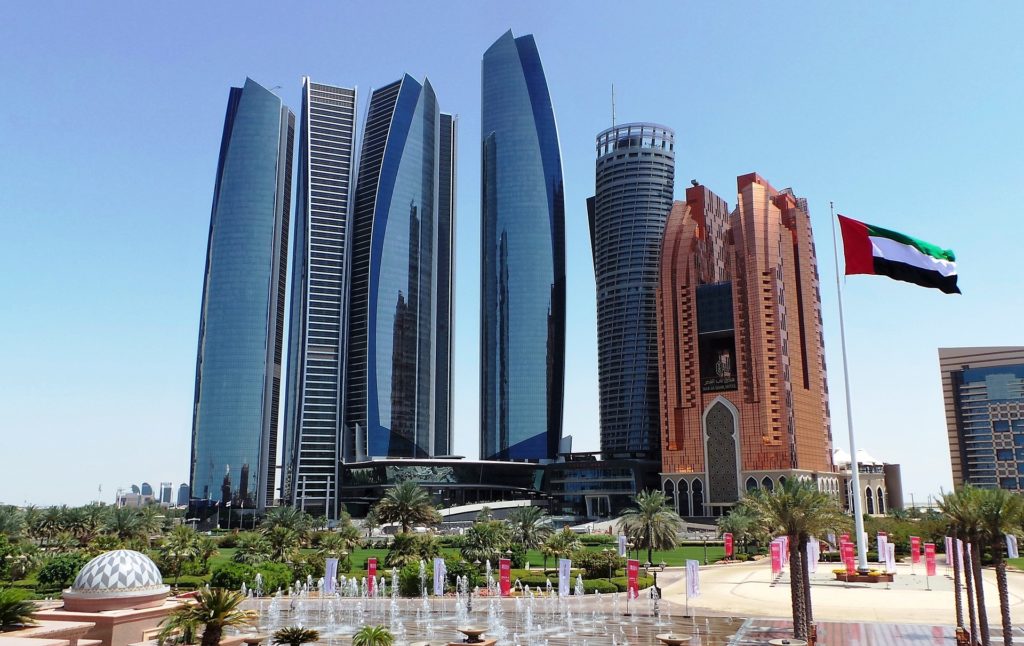
Experience captivating views from Etihad Towers. (Photo: Pixabay)